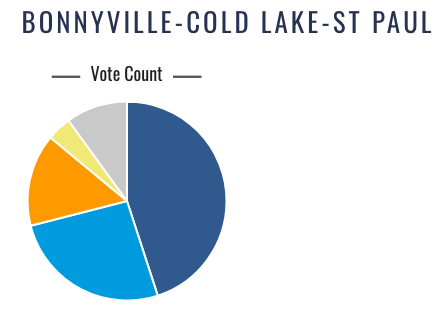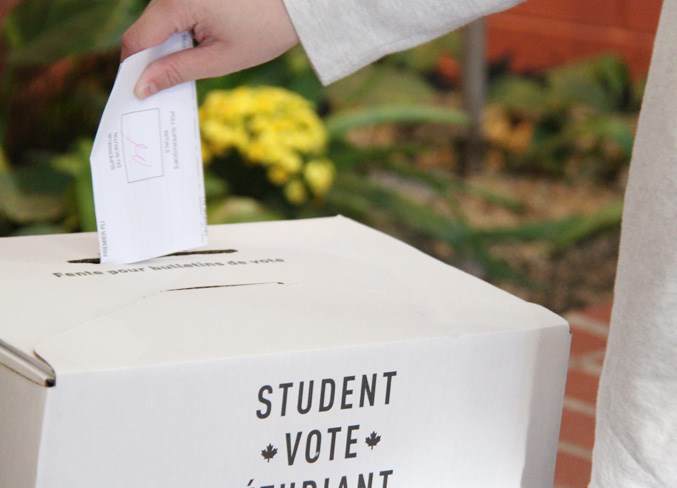Just like their adult counterparts, local students hit the polls for the Alberta election educated.
As part of CIVIX Canada’s Student Vote program, dozens of schools across the Bonnyville-Cold Lake-St. Paul constituency cast their ballots on who they would like to see take the seat as MLA for the region.
Similarly to the local outcome, UCP candidate David Hanson was elected as MLA with 1,012 votes.
“What I saw when the student vote numbers came out yesterday, I was surprised. The kids were pretty darn close with their votes and their thoughts. To me, that’s evidence that the approach was taken seriously by students and that they really gave it some consideration and thought,” emphasized Jimmi Lou Irvine, associate superintendent for teaching and student learning with Northern Lights Public Schools.
In total, 2,267 votes were cast by youth within the constituency.
 This is a pie graph of the results. Dark blue is the UCP, light blue is the Alberta Party, orange is NDP, independent is represented in yellow, and other is grey.
This is a pie graph of the results. Dark blue is the UCP, light blue is the Alberta Party, orange is NDP, independent is represented in yellow, and other is grey.
Alberta Party candidate Glenn Andersen slid into second with 580 of those votes, followed by NDP Kari Whan with 330, independent Kacey Daniels received 150, David Garnett-Bennett, candidate for the Alberta Independence Party ended the polls with 100, and Alberta Advantage Party’s David Inscho had 95.
Student Vote is open to Canadian schools with students in Grades 4 to 12, with Glendon School, Bonnyville Centralized High School, Dr. Bernard Brosseau School, H.E. Bourgoin Middle School, Iron River, École des Beaux-Lacs, and Notre Dame High School taking part.
“This was the 10th time we’ve done this in Alberta since 2004, and the numbers we had this time around were the highest yet in terms of the amount of schools we had signed up,” expressed director of content with CIVIX Canada Dan Allan.
According to Allan, the program was created in 2003 as a creative way of boosting voter turnout.
“I guess the purpose of this is voter turnout in Canada was something that had gone down at a very heavy rate… At the lowest point I think we saw about half of all of the people eligible to vote did so. This was a problem we saw, and we wanted to see how that could be solved. Engaging young people was the way we saw as hopefully solving that issue,” he detailed.
Students spend about a month leading up to the election learning about each candidate, their party, and their platform.
Once they have all of the information they need, they form an opinion and vote.
“I think it’s a great opportunity for students to find out more about the political systems and how parties operate,” said Lakeland Catholic School District board of trustees chair Mary Anne Penner.
Irvine agreed.
“This is a very hands-on opportunity to illustrate to our students on how to be engaged citizens and how to be a part of an election that will impact their families and their education. For our teachers to take that time and bring them into the process, help them understand, and do that in a way that doesn’t present a particular point of view, but gives all of the students an opportunity to access information about all parties is a wonderful opportunity for our students across the division.”
With two children of her own that took part in the voting, Irvine witnessed first-hand how students were bringing what they learned at school, home.
“I have a daughter in Grade 4 and a son in Grade 5 at Iron River School, and on election day, my son was as glued to the TV as we were and was talking about who he voted for and the reasons why, and when he saw candidates names come up, he would talk about that party’s platform. I think the most telling thing for me as a parent, was my daughter was in Saskatchewan with her grandparents, and she’s only nine-years-old, but she was messaging us back and forth and talking about what was happening,” described Irvine.
She continued, “From a parental perspective, I was certainly proud that our teachers took the time to ensure our students were informed about the process and understood, even from just an overall platform perspective, what the different parties represented, and what things were important to them as a larger party.”
Allan explained how it’s vital to instil the importance of voting at a young age, in order to encourage those behaviours later in life.
“The purpose of engaging them young is the hope that by getting them informed and excited about how the system works now, by the time they are eligible to vote at 18, it won’t be a new thing for them,” he exclaimed. “There won’t be that hesitation that’s sometimes there when doing something new.”
Penner said it’s important to start teaching children about the “rights and obligations that come with being a citizen.”
Local teachers were tasked with ensuring their students were making informed decisions when they headed to the polls.
“I think that’s very important because you could just go and say ‘oh, I like this colour so I will vote for the one that’s blue or red,’ but when they learn what each party stands for, they start to form their own opinions about what good government is and who might be the party that would best serve what they want to happen with the government,” Penner exclaimed.
For more photos, click here.



